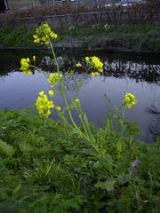
Brassica rapa
Encyclopedia
Brassica rapa L. commonly known as turnip, turnip rape, field mustard or turnip mustard is a plant
widely cultivated as a leaf vegetable
(see mizuna
and napa cabbage
), a root vegetable
(see turnip
), and an oilseed (but not normally rapeseed oil, from a different Brassica species).
In the 18th century the turnip and the oil seed producing variants were seen by Carolus Linnaeus
as being different species who named them B. rapa and B. campestris. However, 20th century taxonomists found that the plants were cross fertile
and thus belonged to the same species. Since the turnip had been named first by Linnaeus, the name Brassica rapa was adopted.
The oilseeds known as canola
are sometimes particular varieties of Brassica rapa (termed Polish Canola) but mostly the related species Brassica napus and Brassica juncea
.
Plant
Plants are living organisms belonging to the kingdom Plantae. Precise definitions of the kingdom vary, but as the term is used here, plants include familiar organisms such as trees, flowers, herbs, bushes, grasses, vines, ferns, mosses, and green algae. The group is also called green plants or...
widely cultivated as a leaf vegetable
Leaf vegetable
Leaf vegetables, also called potherbs, green vegetables, greens, leafy greens or salad greens, are plant leaves eaten as a vegetable, sometimes accompanied by tender petioles and shoots...
(see mizuna
Mizuna
Mizuna , also called Xiu Cai, Kyona, Japanese Mustard, Potherb Mustard, Japanese Greens, California Peppergrass, Spider Mustard, etc., is a Japanese name used primarily for cultivated varieties of Brassica rapa nipposinica but also for Brassica juncea var...
and napa cabbage
Napa cabbage
Napa cabbage , also known as celery cabbage, is a type of Chinese cabbage originating near the Beijing region of China, and is widely used in East Asian cuisine. In much of the world, this is the vegetable referred to as "Chinese cabbage"...
), a root vegetable
Root vegetable
Root vegetables are plant roots used as vegetables. Here "root" means any underground part of a plant.Root vegetables are generally storage organs, enlarged to store energy in the form of carbohydrates. They differ in the concentration and the balance between sugars, starches, and other types of...
(see turnip
Turnip
The turnip or white turnip is a root vegetable commonly grown in temperate climates worldwide for its white, bulbous taproot. Small, tender varieties are grown for human consumption, while larger varieties are grown as feed for livestock...
), and an oilseed (but not normally rapeseed oil, from a different Brassica species).
In the 18th century the turnip and the oil seed producing variants were seen by Carolus Linnaeus
Carolus Linnaeus
Carl Linnaeus , also known after his ennoblement as , was a Swedish botanist, physician, and zoologist, who laid the foundations for the modern scheme of binomial nomenclature. He is known as the father of modern taxonomy, and is also considered one of the fathers of modern ecology...
as being different species who named them B. rapa and B. campestris. However, 20th century taxonomists found that the plants were cross fertile
Cross-fertilization
Cross-fertilization can refer to:*Allogamy, where an ovum from one individual is fertilized with the spermatozoa of another*Heterosis, where different strains are cross-bred to form a hybrid...
and thus belonged to the same species. Since the turnip had been named first by Linnaeus, the name Brassica rapa was adopted.
The oilseeds known as canola
Canola
Canola refers to a cultivar of either Rapeseed or Field Mustard . Its seeds are used to produce edible oil suitable for consumption by humans and livestock. The oil is also suitable for use as biodiesel.Originally, Canola was bred naturally from rapeseed in Canada by Keith Downey and Baldur R...
are sometimes particular varieties of Brassica rapa (termed Polish Canola) but mostly the related species Brassica napus and Brassica juncea
Brassica juncea
Brassica juncea, also known as mustard greens, Indian mustard, Chinese mustard, and leaf mustard, is a species of mustard plant. Subvarieties include southern giant curled mustard, which resembles a headless cabbage such as kale, but with a distinct horseradish-mustard flavor...
.
External links
- PROTAbase on Brassica rapa
- The official Fast Plants website.

